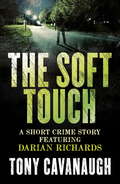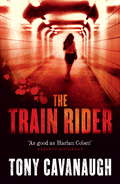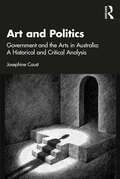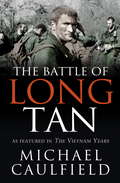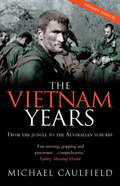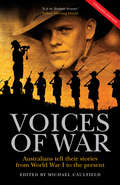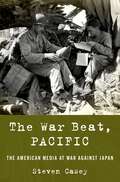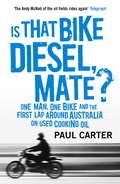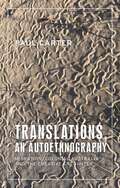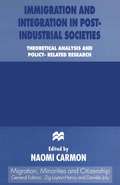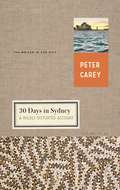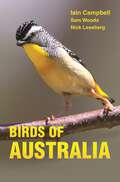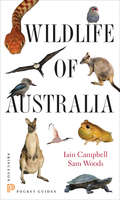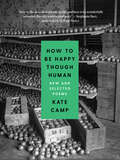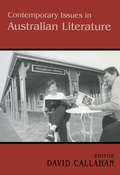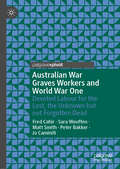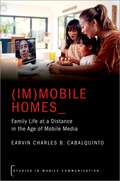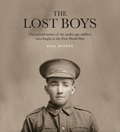- Table View
- List View
The Soft Touch
by Tony CavanaughA gripping short crime story featuring Darian Richards by Australia's bestselling debut crime writer Tony Cavanaugh. Includes previews of his first two full-length novels.[Cavanaugh's debut is] 'as good as Harlan Coben' - Weekend Australian.Darian Richards is a retired homicide investigator. He was one of the best. But chasing monsters eventually took its toll and he quit the force to sit on a jetty on the Noosa River. Or so he planned.After years of service, witnessing the best and the worst of policing, Darian has made up his own mind about justice. Whenever a horrific crime is committed debate rages about the nature of punishment. As far as the law is concerned justice doesn't condone revenge, but tell that to the family of a murder victim or to the woman you can't protect. Darian Richards knows that in the real world, when your hands are tied, sometimes revenge is the only justice.The Soft Touch takes you deep into Darian's past, to the life lessons that made him who he is. He is a man you want looking out for you not looking for you.The Darian Richards SeriesPromiseDead Girl SingThe Soft Touch (Short Story)The Train RiderKingdom of the Strong
The Train Rider (The Darian Richards Series #3)
by Tony Cavanaugh'Tony Cavanaugh brings new depth and dimension to crime fiction in this country' - The Weekend WestOne man pushed Darian Richards to the edge. The man he couldn't catch. The Train Rider.As Victoria's top homicide investigator, Darian Richards spent years catching killers. The crimes of passion, of anger, of revenge ... they were easy. It was the monsters who were hard.Someone was taking girls. At first he'd keep them a week then give them back. Darian warned that wouldn't last. It didn't. From then on, their bodies were never found. Girls kept disappearing. All they had in common was the fact they'd last been seen on a train.The ever-rising list of the vanished broke Darian. Forced him to walk away. Now, retired, watching the Noosa River flow by, the nightmares had finally stopped. Darian was never going back.Then three girls go missing from Queensland trains. Darian knows that the killer is playing him. He has a choice to make. But when the decision means a girl will die, there is no choice. He has to stop this man once and for all. Forever.Tony Cavanaugh is an Australian writer and producer of film and television. The Train Rider is his latest book featuring cop Darian Richards and follows on from the acclaimed crime thrillers Promise and Dead Girl Sing.The Darian Richards SeriesPromiseDead Girl Sing The Soft Touch (Short Story) The Train Rider Kingdom of the Strong
Art and Politics: Government and the Arts in Australia: A Historical and Critical Analysis
by Josephine CaustAustralian governments at all levels have been engaged with arts and culture in many different forms since the beginning of European settlement. The way this has occurred is documented and analysed here, both from an historical and critical perspective. Changing understandings of culture and the significance of Indigenous Culture to Australia receive special attention. While the focus is primarily directed to Federal Government engagement, there is also consideration paid to both state and local government involvement. There is attention paid to the censorship of arts practice by governments as well as the direct interventions by politicians in arts practice. Different approaches to the arts by governments are also considered, as well as attempts to develop a national cultural policy. The impact of the recent pandemic is addressed and various research reports about the arts sector and its relationship with government are also noted. There is then a final discussion about some issues that governments could address in the future, that might ensure a more sustainable Australian arts sector. This book will be of particular interest to scholars of contemporary arts, arts management, cultural history, public policy and cultural policy. It may also interest bureaucrats and politicians.
Art and Politics: Government and the Arts in Australia: A Historical and Critical Analysis
by Josephine CaustAustralian governments at all levels have been engaged with arts and culture in many different forms since the beginning of European settlement. The way this has occurred is documented and analysed here, both from an historical and critical perspective. Changing understandings of culture and the significance of Indigenous Culture to Australia receive special attention. While the focus is primarily directed to Federal Government engagement, there is also consideration paid to both state and local government involvement. There is attention paid to the censorship of arts practice by governments as well as the direct interventions by politicians in arts practice. Different approaches to the arts by governments are also considered, as well as attempts to develop a national cultural policy. The impact of the recent pandemic is addressed and various research reports about the arts sector and its relationship with government are also noted. There is then a final discussion about some issues that governments could address in the future, that might ensure a more sustainable Australian arts sector. This book will be of particular interest to scholars of contemporary arts, arts management, cultural history, public policy and cultural policy. It may also interest bureaucrats and politicians.
The Battle of Long Tan: As featured in The Vietnam Years
by Michael CaulfieldThe truth about the battle that came to define our Vietnam War - from the men who were there.18th August, 1966. 1pm…D Company entered the plantation. They thought that, if they were lucky, they were closing in on perhaps 30 or 40 VC. They were horribly wrong.Over twelve long, bloody and brutal hours, 105 Australian soldiers and three New Zealanders fought off mortar attacks and heavy machine-gun fire, unaware they were facing up to 2500 Viet Cong and North Vietnamese forces. The first major battle of the war for the Australians, our men showed extraordinary courage and, against all odds, they triumphed – although the Vietnamese didn't admit this for another forty years.In The Battle of Long Tan, Caulfield takes us through that hellish day in the Long Tan rubber plantation, combining gripping first-hand accounts from eleven of the men who fought with an authoritative overview of the battle itself – from headquarters to the men in the field.This is as close as you'll get to being there.Michael Caulfield has worked as a composer, musician, TV and film producer, and director. He was the executive producer of the ABC TV series Australians at War. His books with Hachette Australia include The Vietnam Years, War behind the Wire and Voices of War.
The Vietnam Years: From the jungle to the Australian suburbs
by Michael CaulfieldThe Vietnam War was the longest and most divisive war in our history. Almost 60,000 Australians served and more than 500 were killed. At home, thousands protested against the war and conscription and hundreds were sent to jail. THE VIETNAM YEARS is the story of both sides of that war, from the vicious fighting of the jungle patroles and the bravery shown by so many Australians at the famous Battle of Long Tan, to families back home, ripped apart by confusion and anger. From Vung Tau to Nui Dat, from Bankstown to Broadmeadows, this is a book about Australians and for Australians.
The Voices of War: Australians tell their stories from World War I to the present
by Michael CaulfieldDrawn from engagements ranging from World War I through to operations in East Timor and Iraq, these stories are taken from the Australians at War Film Archive, a collection of the memories of more than 2000 Australians who have served, both on the front line and at home.Some are unbelievably, unbearably tragic, even after sixty or seventy years; others are the golden memories of happy, albeit unusual, times. And, more often than not, they are stories that have never been shared with others, even family members. There are stories from winners of the Victoria Cross; from the POW camps of Asia and Europe; from the patrols of Vietnam, through to those who served as peacekeepers in Rwanda and Somalia.There are stories from nurses, from those who have volunteered to serve with aid agencies and stories of ordinary Australians caught up by circumstances and by duty, in wartime. These are their words.
The War Beat, Pacific: The American Media at War Against Japan
by Steven CaseyThe definitive history of American war reporting in the Pacific theater of World War II, from the attack on Pearl Harbor to the atomic bombings of Hiroshima and Nagasaki. After almost two years slogging with infantrymen through North Africa, Italy, and France, Ernie Pyle immediately realized he was ill-prepared for covering the Pacific War. As Pyle and other war correspondents discovered, the climate, the logistics, and the sheer scope of the Pacific theater had no parallel in the war America was fighting in Europe. From Pearl Harbor to Hiroshima and Nagasaki, The War Beat, Pacific provides the first comprehensive account of how a group of highly courageous correspondents covered America's war against Japan, what they witnessed, what they were allowed to publish, and how their reports shaped the home front's perception of some of the most pivotal battles in American military history. In a dramatic and fast-paced narrative based on a wealth of previously untapped primary sources, Casey takes us from MacArthur's doomed defense on the Philippines and the navy's overly strict censorship policy at the time of Midway, through the bloody battles on Guadalcanal, New Guinea, Tarawa, Saipan, Leyte and Luzon, Iwo Jima and Okinawa, detailing the cooperation, as well as conflict, between the media and the military, as they grappled with the enduring problem of limiting a free press during a period of extreme crisis. The War Beat, Pacific shows how foreign correspondents ran up against practical challenges and risked their lives to get stories in a theater that was far more challenging than the war against Nazi Germany, while the US government blocked news of the war against Japan and tried to focus the home front on Hitler and his atrocities.
The War Beat, Pacific: The American Media at War Against Japan
by Steven CaseyThe definitive history of American war reporting in the Pacific theater of World War II, from the attack on Pearl Harbor to the atomic bombings of Hiroshima and Nagasaki. After almost two years slogging with infantrymen through North Africa, Italy, and France, Ernie Pyle immediately realized he was ill-prepared for covering the Pacific War. As Pyle and other war correspondents discovered, the climate, the logistics, and the sheer scope of the Pacific theater had no parallel in the war America was fighting in Europe. From Pearl Harbor to Hiroshima and Nagasaki, The War Beat, Pacific provides the first comprehensive account of how a group of highly courageous correspondents covered America's war against Japan, what they witnessed, what they were allowed to publish, and how their reports shaped the home front's perception of some of the most pivotal battles in American military history. In a dramatic and fast-paced narrative based on a wealth of previously untapped primary sources, Casey takes us from MacArthur's doomed defense on the Philippines and the navy's overly strict censorship policy at the time of Midway, through the bloody battles on Guadalcanal, New Guinea, Tarawa, Saipan, Leyte and Luzon, Iwo Jima and Okinawa, detailing the cooperation, as well as conflict, between the media and the military, as they grappled with the enduring problem of limiting a free press during a period of extreme crisis. The War Beat, Pacific shows how foreign correspondents ran up against practical challenges and risked their lives to get stories in a theater that was far more challenging than the war against Nazi Germany, while the US government blocked news of the war against Japan and tried to focus the home front on Hitler and his atrocities.
Is that Bike Diesel, Mate?: One Man, One Bike, and the First Lap Around Australia on Used Cooking Oil
by Paul CarterOi, mate, is that monstrosity diesel? From the author of the bestsellers Don't Tell Mum I Work on the Rigs, She Thinks I'm a Piano Player in a Whorehouse and This Is Not a Drill, this is the eagerly awaited next installment of Paul Carter's rollicking life.Take one mad adventurer and a motorbike that runs on bio fuel (cooking oil i.e. chip fat to you and me) and send them with one filmmaker on a road trip around Australia just to see what happens. What you get is a story full of outback characters, implausible (but true) situations, unlikely events and unfortunate breakdowns, all at a break neck pace. Never one to sit still for long, this is what Paul Carter did next.Whether you've been shocked, delighted, entertained, horrified - or all of the above - by Paul's stories whether from oil rigs or the road one thing is for sure, they are always high octane adventures.
Translations, an autoethnography: Migration, colonial Australia and the creative encounter (Anthropology, Creative Practice and Ethnography)
by Paul CarterTranslations is a personal history written at the intersection of colonial anthropology, creative practice and migrant ethnography. Renowned postcolonial scholar, public artist and radio maker, UK-born Paul Carter documents and discusses a prodigiously varied and original trajectory of writing, sound installation and public space dramaturgy produced in Australia to present the phenomenon of contemporary migration in an entirely new light. Migrant space-time, Carter argues, is not linear, but turbulent, vortical and opportunistic. Before-and-after narratives fail to capture the work of self-becoming and serve merely to perpetuate colonialist fantasies. The ‘mirror state’ relationship between England and Australia, its structurally symmetrical histories of land theft and internal colonisation, repress the appearance of new subjects and subject relations. Reflecting on collaborations with Aboriginal artists, Carter argues for a new definition of the stranger-host relationship predicated on recognition of Aboriginal sovereignty. Carter calls the creative practice that breaks the cycle of repeated invasion ‘dirty art’. Translations is a passionately eloquent argument for reframing borders as crossing-places: framing less murderous exchange rates, symbolic literacy, creative courage and, above all, the emergence of a resilient migrant poetics will be essential.
Translations, an autoethnography: Migration, colonial Australia and the creative encounter (Anthropology, Creative Practice and Ethnography)
by Paul CarterTranslations is a personal history written at the intersection of colonial anthropology, creative practice and migrant ethnography. Renowned postcolonial scholar, public artist and radio maker, UK-born Paul Carter documents and discusses a prodigiously varied and original trajectory of writing, sound installation and public space dramaturgy produced in Australia to present the phenomenon of contemporary migration in an entirely new light. Migrant space-time, Carter argues, is not linear, but turbulent, vortical and opportunistic. Before-and-after narratives fail to capture the work of self-becoming and serve merely to perpetuate colonialist fantasies. The ‘mirror state’ relationship between England and Australia, its structurally symmetrical histories of land theft and internal colonisation, repress the appearance of new subjects and subject relations. Reflecting on collaborations with Aboriginal artists, Carter argues for a new definition of the stranger-host relationship predicated on recognition of Aboriginal sovereignty. Carter calls the creative practice that breaks the cycle of repeated invasion ‘dirty art’. Translations is a passionately eloquent argument for reframing borders as crossing-places: framing less murderous exchange rates, symbolic literacy, creative courage and, above all, the emergence of a resilient migrant poetics will be essential.
Immigration and Integration in Post-Industrial Societies: Theoretical Analysis and Policy-Related Research (Migration, Diasporas and Citizenship)
by Naomi CarmonNaomi Carmon has brought together a group of distinguished scholars from post-industrial countries to discuss changes in immigration flows, their impact on the receiving countries, and alternative policy responses. Experts in sociology, economics, political science, geography and urban planning base their analyses on evidence from USA, Australia, Britain, France and Israel. They examine past experience and analyze the present situation, in which new types of immigrants, in changing circumstances, are creating new patterns of settlement and integration.
30 Days in Sydney: A Wildly Distorted Account (The\writer And The City Ser. #Vol. 2)
by Peter CareyAfter living abroad for years, novelist Peter Carey returns home to Sydney and attempts to capture its character with the help of his old friends, drawing the reader into a wild and wonderful journey of discovery and rediscovery as bracing as the southerly buster that sometimes batters Sydney's shores. Famous sights such as Bondi Beach, the Opera House, the Harbour Bridge and the Blue Mountains all take on a strange new intensity when exposed to the penetrating gaze of the author and his friends.
Birds of Australia: A Photographic Guide
by Iain Campbell Sam Woods Nick Leseberg Geoff JonesAustralia is home to a spectacular diversity of birdlife, from parrots and penguins to emus and vibrant passerines. Birds of Australia covers all 714 species of resident birds and regularly occurring migrants and features more than 1,100 stunning color photographs, including many photos of subspecies and plumage variations never before seen in a field guide. Detailed facing-page species accounts describe key identification features such as size, plumage, distribution, behavior, and voice. This one-of-a-kind guide also provides extensive habitat descriptions with a large number of accompanying photos. The text relies on the very latest IOC taxonomy and the distribution maps incorporate the most current mapping data, making this the most up-to-date guide to Australian birds.Covers all 714 species of resident birds and regularly occurring migrantsFeatures more than 1,100 stunning color photosIncludes facing-page species accounts, habitat descriptions, and distribution mapsThe ideal photographic guide for beginners and seasoned birders alike
Birds of Australia: A Photographic Guide (PDF)
by Iain Campbell Sam Woods Nick Leseberg Geoff JonesAustralia is home to a spectacular diversity of birdlife, from parrots and penguins to emus and vibrant passerines. Birds of Australia covers all 714 species of resident birds and regularly occurring migrants and features more than 1,100 stunning color photographs, including many photos of subspecies and plumage variations never before seen in a field guide. Detailed facing-page species accounts describe key identification features such as size, plumage, distribution, behavior, and voice. This one-of-a-kind guide also provides extensive habitat descriptions with a large number of accompanying photos. The text relies on the very latest IOC taxonomy and the distribution maps incorporate the most current mapping data, making this the most up-to-date guide to Australian birds.Covers all 714 species of resident birds and regularly occurring migrantsFeatures more than 1,100 stunning color photosIncludes facing-page species accounts, habitat descriptions, and distribution mapsThe ideal photographic guide for beginners and seasoned birders alike
Wildlife of Australia
by Iain Campbell Sam WoodsIdeal for the nature-loving traveler, Wildlife of Australia is a handy photographic pocket guide to the most widely seen birds, mammals, reptiles, amphibians, and habitats of Australia. The guide features more than 400 stunning color photographs, and coverage includes 350 birds, 70 mammals, 30 reptiles, and 16 frogs likely to be encountered in Australia's major tourist destinations. Accessible species accounts are useful for both general travelers and serious naturalists, and the invaluable habitat section describes the Australian bush and its specific wildlife. Animal species with similar features are placed on the same plates in order to aid identification. Wildlife of Australia is an indispensable and thorough resource for any nature enthusiast interested in this remarkable continent. Easy-to-use pocket guide More than 400 high-quality photographs Accessible text aids identification Habitat guide describes the Australian bush and its specific wildlife Coverage includes the 350 birds, 70 mammals, 30 reptiles, and 16 frogs most likely to be seen on a trip around Australia
How to Be Happy Though Human: New and Selected Poems
by Kate CampA timely collection of new and previously published work by one of New Zealand’s most acclaimed poets, How to Be Happy Though Human introduces Kate Camp’s eclectic and musical poetry to international audiences for the first time.How to Be Happy Though Human: New and Selected Poems is Kate Camp’s seventh book of poetry and the first to be published outside New Zealand. Incorporating a grouping of new, previously unpublished work and a selection of important poems from her six earlier collections, this volume introduces North American readers to poetry that has been described by critics as “fearless,” “mesmerizing,” and “containing a surprising radicalism and power.”Camp’s work is recognized for its wide-ranging and eclectic subject matter, its technical control, and its musicality, with pop culture, high culture, the domestic confessional, close observation, and found language featured as recurring elements of style.A timely retrospective that represents a new chapter in Camp’s career, How to Be Happy Though Human promises to gain a wide readership for this thoughtful, engaging, and popular writer.
Contemporary Issues in Australian Literature: International Perspectives
by David CallahanThe contemporary study of Australian literature ranges widely across issues of general cultural studies, the politics of identity (both ethnic and gendered), and the position of Australia within wider postcolonial contexts. This volume intervenes in the most significant of issues in these areas from a variety of international perspectives.
Contemporary Issues in Australian Literature: International Perspectives
by David CallahanThe contemporary study of Australian literature ranges widely across issues of general cultural studies, the politics of identity (both ethnic and gendered), and the position of Australia within wider postcolonial contexts. This volume intervenes in the most significant of issues in these areas from a variety of international perspectives.
Australian War Graves Workers and World War One: Devoted Labour for the Lost, the Unknown but not Forgotten Dead
by Fred Cahir Sara Weuffen Matt Smith Peter Bakker Jo CaminitiThis book relays the largely untold story of the approximately 1,100 Australian war graves workers whose job it was to locate, identify exhume and rebury the thousands of Australian soldiers who died in Europe during the First World War. It tells the story of the men of the Australian Graves Detachment and the Australian Graves Service who worked in the period 1919 to 1922 to ensure that grieving families in Australia had a physical grave which they could mourn the loss of their loved ones. By presenting biographical vignettes of eight men who undertook this work, the book examines the mechanics of the commemoration of the Great War and extends our understanding of the individual toll this onerous task took on the workers themselves.
**Missing**: Family Life at a Distance in the Age of Mobile Media (Studies in Mobile Communication)
by Earvin Charles CabalquintoThe home has been on the forefront of rapid economic, political, social, and technological transformations for many individuals and families across the world. As a country reliant on the exportation of human labor to sustain its national economy, the Philippines exemplifies a valuable case study of the impacts of a globalized and networked society on the everyday dynamics of a transnational family arrangement. Despite ranking among the heaviest Internet users in the world, Filipino citizens are often left with no choice but to navigate digital and transnational environments orchestrated by the uneven distribution of both national and international resources and opportunities. (Im)mobile Homes investigates the role of smartphones, social media channels, and various mobile applications in forging and sustaining intimate ties among dispersed Filipino family members. Examining the digital lifeworlds of transnational Filipino family in Australia, this volume draws on rich ethnographic study to explore the benefits of digital communication as well as the tensions enabled by the influences of socio-cultural structures, socio-economic conditions, technological affordances, and institutional policies and processes on mobile practices. It portrays the physically distributed yet virtually connected nature of the transnational Filipino family through diverse contexts, such as observing family rituals, performing intimate care, and managing crises, and foregrounds their unique strategies in addressing the interruptions of connecting at a distance. Ultimately, this volume underscores how mobile practices of the transnational Filipino family negotiate the pre-existing and broader structural systems that (re)produce marginalization in a digital and global era. Enriched by moving stories of transnational families, (Im)mobile Homes offers a critical lens towards interrogating the possibilities and politics of a home from afar in the digital era.
**Missing**: Family Life at a Distance in the Age of Mobile Media (Studies in Mobile Communication)
by Earvin Charles CabalquintoThe home has been on the forefront of rapid economic, political, social, and technological transformations for many individuals and families across the world. As a country reliant on the exportation of human labor to sustain its national economy, the Philippines exemplifies a valuable case study of the impacts of a globalized and networked society on the everyday dynamics of a transnational family arrangement. Despite ranking among the heaviest Internet users in the world, Filipino citizens are often left with no choice but to navigate digital and transnational environments orchestrated by the uneven distribution of both national and international resources and opportunities. (Im)mobile Homes investigates the role of smartphones, social media channels, and various mobile applications in forging and sustaining intimate ties among dispersed Filipino family members. Examining the digital lifeworlds of transnational Filipino family in Australia, this volume draws on rich ethnographic study to explore the benefits of digital communication as well as the tensions enabled by the influences of socio-cultural structures, socio-economic conditions, technological affordances, and institutional policies and processes on mobile practices. It portrays the physically distributed yet virtually connected nature of the transnational Filipino family through diverse contexts, such as observing family rituals, performing intimate care, and managing crises, and foregrounds their unique strategies in addressing the interruptions of connecting at a distance. Ultimately, this volume underscores how mobile practices of the transnational Filipino family negotiate the pre-existing and broader structural systems that (re)produce marginalization in a digital and global era. Enriched by moving stories of transnational families, (Im)mobile Homes offers a critical lens towards interrogating the possibilities and politics of a home from afar in the digital era.
The Lost Boys
by Paul ByrnesIn the First World War of 1914–1918, thousands of boys across Australia and New Zealand lied about their age, forged a parent’s signature and left to fight on the other side of the world. Though some were as young as thirteen, they soon found they could die as well as any man. Like Peter Pan’s lost boys, they have remained forever young. These are their stories. This extraordinary book captures the incredible and previously untold stories of forty Anzac boys who fought in the First World War, from Gallipoli to the Armistice. Featuring haunting images of the boys taken at training camps and behind the lines, these tales are both heartbreaking and rousing, full of daring, ingenuity, recklessness, random horror and capricious luck. A unique perspective on the First World War, The Lost Boys is military history made deeply personal, a powerful homage to youthful bravery and a poignant reminder of the sacrifice of war.
